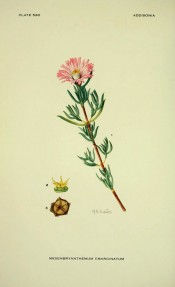Lampranthus emarginatus N.E.Br.
Stems erect, branched, leaves slender, keeled, with translucent dots, the flowers magenta and numerous. To 45cm. [RHSD, Hortus].
Horticultural & Botanical History
First botanically described by Linnaeus as Mesembryanthemum emarginatum in 1762 [Sp. Pl. ed.2, vol.1, p.692/1762]. Placed in Lampranthus as Lampranthus emarginatus by N. E. Brown in 1930 [Gard. Chron. Ser. III, vol.lxxxvii, p.212/1930].
Introduced to Britain in 1732. [JD]. Described and figured in Addisonia: ‘Mesembryanthemums have long been popular as greenhouse plants, both for their attractive foliage and their usually showy flowers. In South Africa, the native home of most of the species and their center of distribution, many of them are curious and bizarre in form, some imitating in their growth the stones of the hot desert or arid regions in which they grow. They are nearly all indiscriminately called fig-marigolds or mesembryanthemums in cultivation, but doubtless other names exist in their native country.
Their flowers, mostly large and showy, are at their best in hot sunshine, usually closing at night or in shadow. Many species have definite hours for opening their flowers.
The fleshy capsular fruits of these plants are peculiarly interesting for their hygroscopic character, opening when wet, and closing when dry; this habit due to the climate of the desert regions in which they grow, where the seeds have a better chance to start life in rainy weather, hence it is then that they are scattered.
Mesembryanthemums propagate easily from cuttings or seed. The plants grow best under airy conditions, and while they may be bedded out in summer, must be taken in before killing frost. They resent overwatering, but should never be allowed to become completely dry.
Our present subject was raised from seed from the Botanical Garden at Zurich, sent under the name of M. flexuosum. While it differs from M. emarginatum in having most of the petals acute or acutish, and light pink in color, it seems best included under that species for the present, although it may represent either an undescribed species or a hybrid.’ [Addisonia vol.18 pl.590/1933].
History at Camden Park
Obtained from the Sydney Botanic Garden, 28th October 1846. [RBGS AB].
Notes
Mesembryanthemum emarginatum Eckl. & Zeyh. (1837) = Mesembryanthemum linguiforme L.
Published Feb 11, 2009 - 03:41 PM | Last updated Feb 12, 2012 - 04:33 PM
| Family | Aizoaceae |
|---|---|
| Category | |
| Region of origin | South Africa, including Cape Province |
| Synonyms |
|
| Common Name | Livingstone daisy |
| Name in the Camden Park Record | Mesembryanthemum emarginatum
|
| Confidence level | medium |
